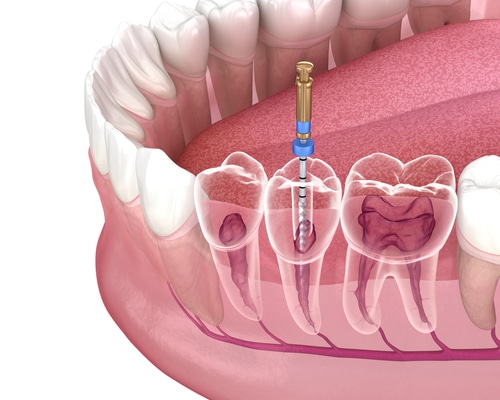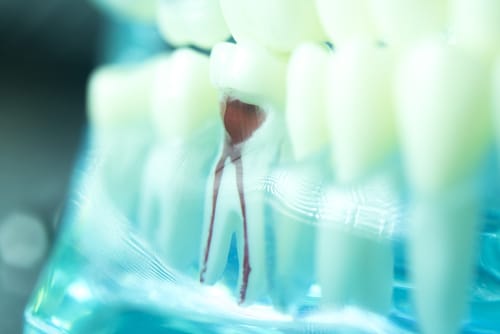Root Canal Therapy in Gulfport, MS
One in four adults between the ages of 18 and 64 in the United States has at least one cavity. Cavities can quickly cause severe decay that puts your oral and general health at risk. To help prevent the loss of the tooth and other complications, Dr. John Hopkins, DDS, offers root canal therapy at Centre for Smile Designs.
Learn more about what root canal therapy is and how to know if you might need it.
What Is Root Canal Therapy?
 Root canal therapy is a dental procedure that removes a tooth’s infected pulp, relieving the pain that an abscessed or infected tooth can cause. The tooth then receives a filling and a crown to protect it from further infections.
Root canal therapy is a dental procedure that removes a tooth’s infected pulp, relieving the pain that an abscessed or infected tooth can cause. The tooth then receives a filling and a crown to protect it from further infections.
A root canal is necessary when bacteria finds its way into the tooth. This can occur if you have left a cavity untreated for a long time or if your tooth has suffered trauma.
Some of the most common signs that you may need root canal therapy include:
- Tooth pain that doesn’t go away
- Swollen gums
- Swollen jaw
- Tooth sensitivity to heat and cold
- Tooth discoloration
- Pimple on the gums
- Chipped and cracked tooth
- Loose tooth
- Pain when applying pressure
After the root canal, the tooth will receive a crown to protect it.
Dr. Hopkins’ goal is always to save the tooth, but if the infection is very advanced or there is not enough tooth left for a crown, another option can be to extract the tooth and place a post and cap (dental implant).
Using mini dental implants, which are titanium posts that go into your jawbone and gums, you can get a false tooth in place without risking the kind of bone loss that can occur when there is no root to stimulate the jawbone.
Benefits of Root Canal Therapy
A root canal can help relieve the pain that the infected tooth pulp causes. The relief is immediate.
Root canal therapy can also allow you to keep the tooth root in place. Your jawbone receives stimulation from the roots of your teeth, leading it to create bone cells that replace the ones that die naturally. If a root is missing, as can occur if you have a tooth extraction, that area of your jawbone doesn’t receive the stimulation it needs. This causes bone loss. Keeping the root in place prevents this problem.
Additionally, the infected pulp contains an accumulation of bacteria that can damage your gums, jaw, and other teeth. Root canal therapy can prevent the spread of bacteria.
Root canal therapy is a quick procedure. Dr. Hopkins can perform it in one appointment.
Getting Root Canal Therapy
If you have a tooth that might be infected, schedule a consultation with Dr. Hopkins at Centre for Smile Designs.
He will examine the tooth, ask about your medical history and oral hygiene, and enquire about the goals you have for treatment. If, for example, you prefer to extract the tooth, let him know so he can offer mini dental implants to help you retain the full use of your bite.
Dr. Hopkins will take CBCT X-rays to examine your jawbone as well as neighboring teeth. This will give him an idea of the extent of the damage so he can recommend the best treatment.
If he thinks you are a good candidate for a root canal, he will talk to you about costs and what your payment options are. He will also tell you about the anesthesia he will use for the procedure. If you have dental anxiety, you can ask for sedation.
The procedure begins with Dr. Hopkins numbing the tooth and surrounding gums. He will then place a dental dam, which isolates the tooth and keeps it dry.
 Dr. Hopkins will make a small hole at the top of the tooth from which he will remove the nerves, tissues, and blood vessels that make up the tooth’s pulp.
Dr. Hopkins will make a small hole at the top of the tooth from which he will remove the nerves, tissues, and blood vessels that make up the tooth’s pulp.
Once the pulp is out of the way, Dr. Hopkins will clean and disinfect the root canals and pulp chamber, then fill the canal with a flexible material called gutta-percha.
To seal the tooth and prevent bacteria from entering it again, he can place a temporary dental filling.
The entire root canal procedure can take about an hour.
Most people choose to have a crown placed on the tooth to keep it protected. If that is your choice, Dr. Hopkins will create an impression of your tooth and send it to the lab that will create the crown. This process takes about two weeks.
Once the crown is ready, you will need to come in for another appointment. Dr. Hopkins will remove some of your tooth’s enamel to be able to cement the crown in place.
Choosing Mini Dental Implants
If the tooth is severely damaged and a root canal might not offer the results you want, you can choose to get a mini dental implant. This procedure requires the extraction of the infected tooth and the insertion of a titanium post with a false tooth.
Mini dental implants are much faster to install than standard implants and they don’t require bone grafting, so most people can get them in place on the same day as the extraction.
Dr. Hopkins will place a temporary false tooth on the post until the lab can create your permanent tooth.
Root Canal Therapy Recovery
Recovery from root canal therapy can take about a week. You can use cold compresses and over-the-counter painkillers as needed.
During the first couple of days, stick to soft foods. You can then introduce solid foods as your comfort level improves.
You can brush and floss normally, but try to steer clear of the treated tooth. To keep bacteria away, you can use an antibacterial mouthwash.
Get Help for an Infected Tooth
An infected tooth can cause pain and can put your oral health at risk. Avoid serious complications by reaching out to Dr. John Hopkins at Centre for Smile Designs. With an expert ready to help you, you can get the relief you need. Call today for a consultation.
